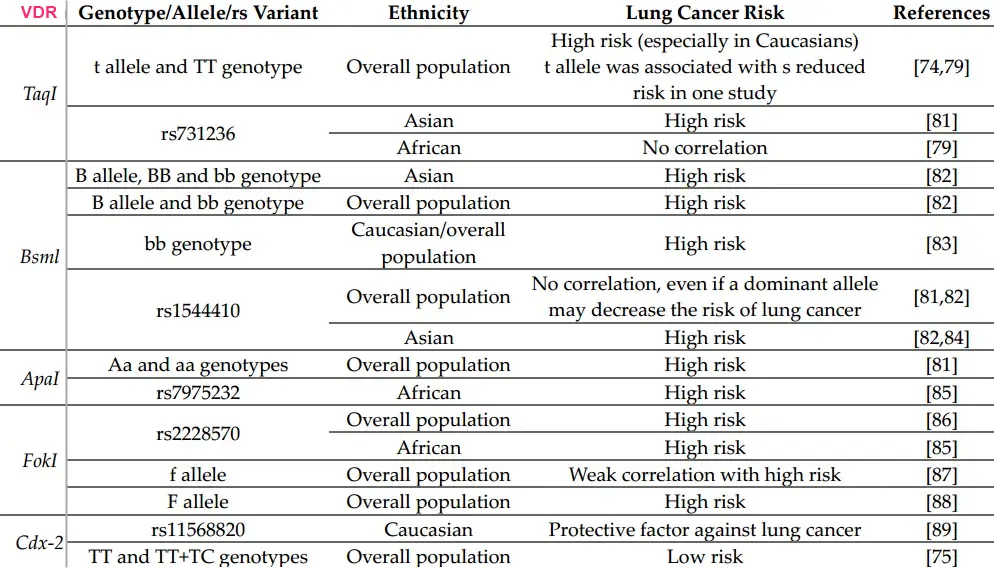Overview Lung cancer and vitamin D
Vitamin D Life - Lung Cancer and Meta-analysis
{category}
Vitamin D Life - studies in both categories Lung Cancer and Vitamin D Receptor
This list is automatically updated
{category}
Lung Cancer: Role of Vitamin D, Vitamin D-Dependent Proteins, and Vitamin D Receptor - June 2024
Exploring the Role of Vitamin D, Vitamin D-Dependent Proteins, and Vitamin D Receptor Gene Variation in Lung Cancer Risk
Int. J. Mol. Sci. 2024, 25, 6664. https://doi.org/10.3390/ijms25126664
Tudor Ciocarlie 4, Alexandru Catalin Motofelea 2,*, Nadica Motofelea 3, Alina Gabriela Dutu 4, Alexandra Craciun 4, Dan Costachescu 5, Ciprian loan Roi 6, Ciprian Nicolae Silaghi 4 and Andreea Crintea 4


Lung cancer has an unfavorable prognosis with a rate of low overall survival, caused by the difficulty of diagnosis in the early stages and resistance to therapy. In recent years, there have been new therapies that use specific molecular targets and are effective in increasing the survival chances of advanced cancer. Therefore, it is necessary to find more specific biomarkers that can identify early changes in carcinogenesis and allow the earliest possible treatment. Vitamin D (VD) plays an important role in immunity and carcinogenesis. Furthermore, the vitamin D receptor (VDR) regulates the expression of various genes involved in the physiological functions of the human organism. The genes encoding the VDR are extremely polymorphic and vary greatly between human populations.
To date, there are significant associations between VDR polymorphism and several types of cancer, but the data on the involvement of VDR polymorphism in lung cancer are still conflicting. Therefore, in this review, our aim was to investigate the relationship between VDR single-nucleotide polymorphisms in humans and the degree of risk for developing lung cancer. The studies showcased different gene polymorphisms to be associated with an increased risk of lung cancer; TaqI, ApaI, BsmI, FokI, and Cdx2. In addition, there is a strong positive correlation between VD deficiency and lung cancer development. Still, due to a lack of awareness, the assessment of VD status and VDR polymorphism is rarely considered for the prediction of lung cancer evolution and their clinical applicability, despite the fact that studies have shown the highest risk for lung cancer given by TaqI gene polymorphisms and that VDR polymorphisms are associated with more aggressive cancer evolution.
📄 Download the PDF from Vitamin D Life
Has Lung Cancer, like many other cancers,COVID, etc. learned how to protect itself from Vitamin D by altering the VDR?
Cost of CT scans and Vitamin D for a 20% reduction in lung cancer deaths
CT: early detection: Cost $800/year
Vitamin D prevention: Cost $ 5/year
- Note: no proof for Vitamin D and lung cancer as of May 2014, but proof for many other cancers and diseases
- Cancer patients 64% less likely to die if have a high level of vitamin D – Dec 2011
- Vitamin D would also prevent many other forms of Cancer and health problems
Estimation of the cost of CT scan per pack
Assume same number years of smoking at CT scanning
Assume 400 packs per year (> the minimum of 32/year)
Cost of scan to the public per pack = $2
See also Lung cancer decreased by 7.5% for every 1260 feet in altitude
Yet another reason to think that Lung Cancer might be reduced with vitamin D
Life Extension Magazine March 2007 - Vitamin D and Cancers such as Lung Cancer
Prevention of Lung Cancer: Future Perspective with Natural Compounds
See also Vitamin D Life
Smoking reduces vitamin D - many studies an overview
One third of lung disease patients in China had less than 4ng of vitamin D – May 2012
Low vitamin D strongly related to death due to tobacco cancer, but not others – March 2013
Cancer patients 64% less likely to die if have high level of vitamin D – Dec 2011 has the following chart

PubMed for Lung Cancer and vitamin D includes
Vitamin D status and the risk of lung cancer: a cohort study in Finland free PDF, small study - helped women, but not men
- Lower levels of UVB irradiance were independently associated with higher incidence rates of lung cancer in 111 countries.
Cancer intervention trials using Vitamin D
Lung Cancer 4X less for some races (smoking 10 cig. per day) - Aug 2018
Tobacco biomarkers and genetic/epigenetic analysis to investigate ethnic/racial differences in lung cancer risk among smokers
Smoking changes gene activation to different amount in different races

📄 Download the PDF from Vitamin D Life
Lung Cancer factoids from The Body by Bill Bryson, 2019
80 percent of all men smoked by the late 1940s—but very few of them developed lung cancer.
The upshot was that by the late 1950s the average smoker was taking in more tar and nicotine than he had before filters were invented.
American Medical Association took 15 years to endorse the surgeon general’s finding.
- can anticipate getting change from AMA about Vitamin D will take decades - Comment by founder of Vitamin D Life
As late as 1973, Nature ran an editorial backing women’s smoking during pregnancy on the grounds that it calmed their stress.
Nearly one-third of people below the poverty line (in the US) still smoke, and the habit continues to account for one-fifth of all deaths.
Why is the number of lung cancers in people who have never smoked increasing?
" “If lung cancer in never-smokers were a separate entity, it would be in the top 10 cancers in the U.S.” for both incidence and mortality."
"A 2019 study in South Korea diagnosed lung cancer in 0.45% of never-smokers, compared to 0.86% of smokers. "
- but the US never screens for lung cancer in never-smokers
Perhaps many cancers are increasing: toxins, poor food, less vitamin D, radon, family history of lung cancer . . .
